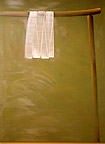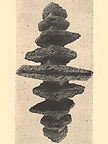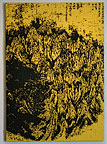Quick: how much does the average person know about Korea? Answer: even if generally well-informed -- probably next-to-nothing. But this relative ignorance is quite understandable. After all, imperial Japanese occupation eliminated even the peninsula's name from the world map, in a brutal attempt to wipe out Korea's unique culture. As a survivor, the spirit of Korea is essential curricula for us all, assaulted as we all are as formulaic, monoculture makes our global village into a mall, paving our azure planet over into a parking lot.
To assist our playing "catch-up" with Korean culture, San Francisco's Asian Art Museum recently mounted two unprecedented exhibitions, antique and modern, Goryeo Dynasty: Korea's Age of Enlightenment and Leaning Forward, Looking Back. For those unable to savor the visual incense first-hand, the respective catalogues will provide stimulating perusal and invaluable reference.
The Goryeo Dynasty is arguably the largest Korean art exhibition on Western shores. Specifically, it's the first gathering outside of Korea of pictorial arts from the five-century span (918-1392) from which the nation draws its name. Following the unification of the peninsula under the Silla dynasty, this half millennia marks Korea's golden age, similar to China's T'ang. (618-907) Drawing from 35 lenders spanning the globe, the collection includes sculpture and ceramics, paintings, scriptures, and related arts.
Buddhism was the national and state religion, and Goryeo rulers patronized a fluorescence of courtly and Buddhist arts unparalleled in elegance and refinement. The Buddha that greeted visitors upon entrance is positively one of the most lovely I have ever seen, whose purity and simplicity coupled with dynamic realization in space create a most compelling evocation of awakened and awakening presence. And such serves as a good rubric for Korean art in general: simplification through design combined with an energetic vitalism.
A monumental Avalokiteshvara (embodiment of the Buddha's compassion) was believed to be twelve feet tall (that's what the catalog says) but when the Museum unpacked it and discovered it was seventeen feet tall, they happily knocked out some ceiling space so that viewers could commune with this masterpiece of devotional art. Musem director Emily Sano likened it to a Mona Lisa of Eastern art. As in most of these pieces, here too we see careful composition serving as an armature for an incredible, splendid detail.
A sculpture of the same deity in a seated posture shows Chinese, Nepalese, and Tibetan influences. (One museumgoer remarked to this Reviewer they were surprised to see a Buddha in such a relaxed position. Well, it's the posture assumed while gazing at the moon, and its reflection in the water, comparing which is more real. Such happy philosophy doesn't require the sturm und drang of Rodin's The Thinker).
Over a dozen Buddhist scriptures have appeal beyond followers of the Way, for their illustrations, such as a really remarkable Manjushri. Of course the first books printed with movable type originated in Korea, propagation of the Dharma (the teachings) being a means of generating merit. Students will note the importance throughout the exhibit of charactgers lesser known to European-based Buddhism: Amitabha Buddha (Amita Jeon), as well as Sudhana, the "little pilgrim" of the conclusion of the Avatamsaka Sutra.
The delicate celadon ceramics are so exquisite as to enchant even the most causal layperson. Close inspection, however, often reveals a certain assymetry, such as in the ewer from the Museum's own collection, giving them a wonky interplay between perfection and imperfection, which Japanese artists were to extend into an art unto itself.
The Goryeo Dynasty catalog includes all the works, in full-size reproductions and full descriptive texts, accompanied by essays from top scholars. Probably the largest book of Korean art to date, it is superbly produced. Any survey of this kind must balance connoisseurship, and contextualization, and this one leans towards the former pole, but there's nothing wrong with that. This exhibit will remain a keystone reference for ages to come.
Having moved from Golden Gate Park, this is the first major show at the new Asian, the first museum outside Korea to have a full-time curator of Korean art. Shining in that role, Prof. Kumja Paik Kim pulled off a miracle for which we can all be grateful.

|

|

|
Creating a dialogue between old and new, the Asian simulatenously exhibited eight contemporary Korean artists, showing the present as well as the past. Leaning Forward, Looking Back spotlights the work of eight artists, in their 40s and 50s, whose multiple points of view and tactics reflect a unitary national tradition. The show wasn't organized, however, to illustrate any preconceved theory but rather reflects a common urgency, as national heritage is threatened by Disneyfication. (In 2000, the old Asian mounted a show of contemporary Korean art, Identity and Alienation that was stimulating but haphazard; this one coheres. Kudos to curator Jeff Kelly.)
Of the four men and women represented, all are top tier. Song Hyun-sook's is marries Eastern calligraphy with Western representationalism, painting superbly contemplative canvases in which very gestural, delicate parallel lines portray veils, jars, etc. In 8 Brushstrokes,for example, 8 strokes conjure clothesline and clothes -- and with it an entire, ancient culture of washerwomen. In Kim Hong-joo's paintings, thousands of single strokes accumulate to create large leaves and flowers.
U Sunok evokes the metaphysics of presence and absence, through the medium of installation. In the center of one room, an i.v. bottle drips several feet down onto a hotplate, creating sizzling steam clouds of insubstantial, beautiful spirit. Elsewhere, a chamber shows short clips of her hands presenting the viewer with various objects, and then just her hands. Jung Jong-mee, on the other hand, uses floor material from traditional Korean houses as her media, collaging and dying and overlaying their swatches to create meditations on the primal elements (earth, fire, water, etc.), through their associated colors.
One of the show's iconoclasts is Whang Inkie replicating large-scale traditional Korean landscapes which on close inspection are revealed to be made out of stainless steel with silicon dimples and, elsewhere, legos. Bracketing the exhjibit are Cho Duck-hyun's pack of sculpted dogs in ancient hieractic style, encrusted with Korean soil. They guard the entrance as a kind of faux archeological discovery, and there are more dogs at the back of the museum in a huge deep pit flanked by sacks of earth dug up by professional archeologists, whose evident traces are part of the statement.
Kim Young-jin's insallation is an extremely poetic, provocative slide projection of a map, which is dripped, washed, splashed and wiped by actions of water. It calls into question what's contained within the graphic lines of a ruler's map. And photographer Lee Jungjin creates enigmatic, evocative emblems of vanishing civilizations, whether New Mexican or Korean, printed on traditional mulberry paper.
While we in the West are still catching up on several millennia of Asian art, contemporary artists in Asia have been catching up on several centuries of Western art. Here East meets West, in the East. It's a landmark encounter.
Former Arts Editor for Asian Week, San Francisco-based author Gary Gach's home page is :I:n:t:e:r:b:e:I:n:g: